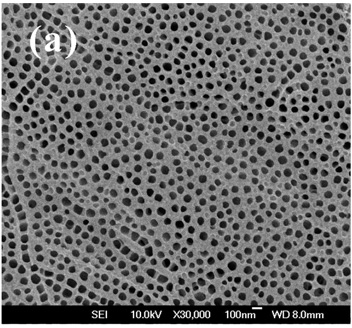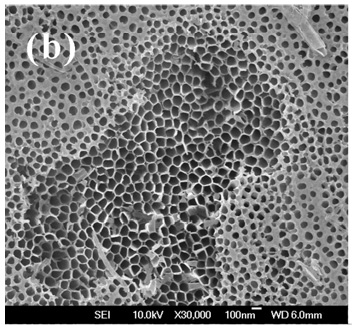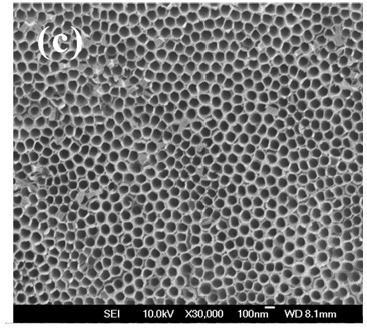Method for preparing independent and ordered titanium oxide nano tube array film
A technology of titanium oxide nanotubes and arrays, applied in coatings, surface reaction electrolytic coatings, electrolytic coatings, etc., can solve problems such as increasing operational complexity, and achieve simple and easy synthesis processes, simple and easy processes, and complete films Effect
- Summary
- Abstract
- Description
- Claims
- Application Information
AI Technical Summary
Problems solved by technology
Method used
Image
Examples
Embodiment 1
[0026] An ethylene glycol solution containing 0.25 wt% ammonium fluoride and 2 vol% water was used as the electrolyte. Ti was used as the working electrode, Pt was used as the counter electrode, and the distance between the two electrodes was set at 3 cm. Oxidized at 20°C and 60V for 3 hours, a titanium oxide nanotube array film with a thickness of 35 microns was obtained on the Ti sheet. The titanium sheet was directly immersed in distilled water without ultrasonic treatment, soaked for 12 hours, taken out, and placed in a fume hood. Drying by blowing air at a slow speed makes the nanotube arrays detach from the Ti substrate. If necessary, during the detachment process, a corresponding force is applied to the substrate to help the detachment of the nanotube array film. Figure 1A SEM images of the surface topography of the obtained free-standing titania nanotube arrays.
Embodiment 2
[0028] An ethylene glycol solution containing 0.25 wt% ammonium fluoride and 2 vol% water was used as the electrolyte. Ti was used as the working electrode, Pt was used as the counter electrode, and the distance between the two electrodes was set at 3 cm. After oxidizing at 20°C and 60V for 3 hours, a titanium oxide nanotube array film with a thickness of 35 microns was obtained on the Ti sheet. After the titanium sheet was ultrasonically treated for 30 seconds, it was immersed in distilled water, soaked for 12 hours, taken out, and ventilated. Slow air blowing and drying in the cabinet, so that the nanotube array is separated from the Ti substrate. If necessary, during the detachment process, a corresponding force is applied to the substrate to help the detachment of the nanotube array film. Figure 1B SEM images of the surface topography of the obtained free-standing titania nanotube arrays.
Embodiment 3
[0030] An ethylene glycol solution containing 0.25 wt% ammonium fluoride and 2 vol% water was used as the electrolyte. Ti was used as the working electrode, Pt was used as the counter electrode, and the distance between the two electrodes was set at 3 cm. After oxidizing at 20°C and 60V for 3 hours, a titanium oxide nanotube array film with a thickness of 35 microns was obtained on the Ti sheet. After the titanium sheet was ultrasonically treated for 70 seconds, it was then immersed in distilled water, soaked for 12 hours, taken out, and ventilated. Slow air blowing and drying in the cabinet, so that the nanotube array is separated from the Ti substrate. If necessary, during the detachment process, a corresponding force is applied to the substrate to help the detachment of the nanotube array film. Figure 1C Scanning electron micrographs of the surface topography of independent titania nanotube arrays obtained for comparison Figure 1A ~ 1C It can be seen that ultrasonic tre...
PUM
| Property | Measurement | Unit |
|---|---|---|
| thickness | aaaaa | aaaaa |
| thickness | aaaaa | aaaaa |
Abstract
Description
Claims
Application Information
 Login to View More
Login to View More - R&D
- Intellectual Property
- Life Sciences
- Materials
- Tech Scout
- Unparalleled Data Quality
- Higher Quality Content
- 60% Fewer Hallucinations
Browse by: Latest US Patents, China's latest patents, Technical Efficacy Thesaurus, Application Domain, Technology Topic, Popular Technical Reports.
© 2025 PatSnap. All rights reserved.Legal|Privacy policy|Modern Slavery Act Transparency Statement|Sitemap|About US| Contact US: help@patsnap.com



